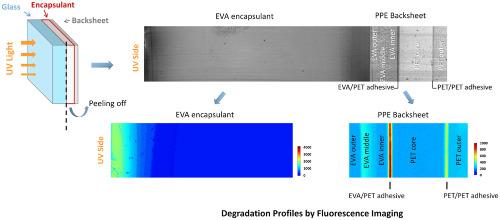当前位置:
X-MOL 学术
›
Prog. Photovoltaics
›
论文详情
Our official English website, www.x-mol.net, welcomes your
feedback! (Note: you will need to create a separate account there.)
Fluorescence imaging analysis of depth‐dependent degradation in photovoltaic laminates: insights to the failure
Progress in Photovoltaics ( IF 8.0 ) Pub Date : 2019-12-11 , DOI: 10.1002/pip.3212 Yadong Lyu 1 , Andrew Fairbrother 1 , Jae Hyun Kim 1 , Mengyan Gong 1 , Li‐Piin Sung 1 , Stephanie S. Watson 1 , Xiaohong Gu 1
Progress in Photovoltaics ( IF 8.0 ) Pub Date : 2019-12-11 , DOI: 10.1002/pip.3212 Yadong Lyu 1 , Andrew Fairbrother 1 , Jae Hyun Kim 1 , Mengyan Gong 1 , Li‐Piin Sung 1 , Stephanie S. Watson 1 , Xiaohong Gu 1
Affiliation

|
Accurate evaluation of the reliability of photovoltaic (PV) packaging materials is critically important for the long‐term safe operation of modules. However, the complexity of the laminated systems due to their multilayered and multicomponent structures and diverse aging mechanisms makes a thorough system evaluation very challenging, especially when the degradation is non‐uniform through the thickness. In such a case, neither surface nor bulk measurements can present a clear picture of the degradation profile. In this study, fluorescence imaging was developed to visualize the degradation depth‐profiles of an aged laminated PV system. A glass/ethylene vinyl acetate (EVA) encapsulant/poly(ethylene terephthalate) (PET)‐PET‐EVA (PPE) backsheet laminate was weathered with the glass‐side facing an ultraviolet (UV) light source for 3840 h. Cross‐sectional fluorescence images revealed a non‐uniform distribution of degradation species across the thickness of the EVA encapsulant, providing greater insight into the mechanisms of degradation, which are unavailable by traditional bulk‐based methods. In addition, strong fluorescence emissions were observed from the two thin adhesive layers of the aged backsheet, indicating severe degradation of the adhesives and a potential for interlayer delamination. This method is further confirmed with other microscale characterization techniques. The changes in optical (yellowness index), chemical (oxidation, UV absorber concentration), mechanical (Derjaguin‐Muller‐Toporov modulus), and thermal (melting enthalpy) properties of the EVA encapsulant were found to be related to fluorescence profiles, following the attenuation of UV light. This study highlights that fluorescence imaging is a spatially‐resolved and sensitive method for rapid failure assessment and in‐depth mechanism study for complex PV‐laminated system.
中文翻译:

光伏层压板中深度依赖降解的荧光成像分析:对失败的见解
准确评估光伏(PV)包装材料的可靠性对于模块的长期安全运行至关重要。但是,由于叠层系统具有多层和多组分结构以及多种老化机制,因此其复杂性使全面的系统评估非常具有挑战性,特别是当整个厚度的降级不均匀时。在这种情况下,表面和体积测量都无法呈现出降解曲线的清晰图片。在这项研究中,开发了荧光成像技术以可视化老化的层压PV系统的降解深度轮廓。将玻璃/乙烯醋酸乙烯酯(EVA)密封剂/聚对苯二甲酸乙二醇酯(PET)-PET-EVA(PPE)底片层压板风化,使玻璃面面向紫外线(UV)光源3840小时。横截面荧光图像显示,降解物质在EVA密封剂的整个厚度上分布不均匀,从而提供了对降解机理的更深入了解,而传统的基于体积的方法则无法做到这一点。另外,从老化的底片的两个薄粘合剂层观察到强烈的荧光发射,表明粘合剂的严重降解和潜在的层间分层。其他微尺度表征技术进一步证实了该方法。发现EVA封装胶的光学(黄色指数),化学(氧化,紫外线吸收剂浓度),机械(德杰金-穆勒-托普洛夫模量)和热(熔融焓)性质的变化与荧光分布有关,随温度变化。紫外线的衰减。
更新日期:2019-12-11
中文翻译:

光伏层压板中深度依赖降解的荧光成像分析:对失败的见解
准确评估光伏(PV)包装材料的可靠性对于模块的长期安全运行至关重要。但是,由于叠层系统具有多层和多组分结构以及多种老化机制,因此其复杂性使全面的系统评估非常具有挑战性,特别是当整个厚度的降级不均匀时。在这种情况下,表面和体积测量都无法呈现出降解曲线的清晰图片。在这项研究中,开发了荧光成像技术以可视化老化的层压PV系统的降解深度轮廓。将玻璃/乙烯醋酸乙烯酯(EVA)密封剂/聚对苯二甲酸乙二醇酯(PET)-PET-EVA(PPE)底片层压板风化,使玻璃面面向紫外线(UV)光源3840小时。横截面荧光图像显示,降解物质在EVA密封剂的整个厚度上分布不均匀,从而提供了对降解机理的更深入了解,而传统的基于体积的方法则无法做到这一点。另外,从老化的底片的两个薄粘合剂层观察到强烈的荧光发射,表明粘合剂的严重降解和潜在的层间分层。其他微尺度表征技术进一步证实了该方法。发现EVA封装胶的光学(黄色指数),化学(氧化,紫外线吸收剂浓度),机械(德杰金-穆勒-托普洛夫模量)和热(熔融焓)性质的变化与荧光分布有关,随温度变化。紫外线的衰减。











































 京公网安备 11010802027423号
京公网安备 11010802027423号